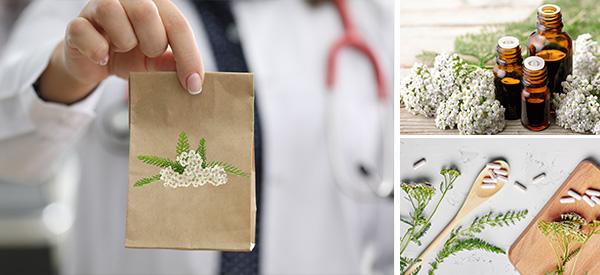
The Plant Doctors Are Begging People To Grow
The medical system is a mess. No matter where you are in the world, chances are good that you can agree with this statement. Health care is expensive, wait times are extensive, and the situation worsens with each passing day. The system that is supposed to keep us healthy is severely broken, and there is no solution in sight.
Luckily, there are alternative options out there that are readily available to you regardless of the state of the healthcare system or the global climate. In fact, there are natural options for almost every possible ailment, and understanding these options is crucial to living a prepared lifestyle.
One such option that is often overlooked, ignored, or misunderstood is Yarrow.
If there is a plant that should be in your garden, it is this one.
⇒ Get Your Own Yarrow Seeds, Last 30 Packs Left!
What is Yarrow?
Yarrow (Achillea millefolium) is a plant that grows all over the globe in almost every country and climate. It has been used to create medicines for centuries and has numerous health benefits. Yarrow is a herbaceous flowering perennial plant that is part of the sunflower family and closely related to chamomile and chrysanthemum. Yarrow has been used in traditional medicine since ancient times.
Today, Yarrow is vastly underutilized, despite its impressive benefits. The best part is that it is effortless to grow and will flourish almost anywhere. A great addition to any garden, Yarrow not only looks great, but it has many health benefits as well.
Other Names For Yarrow.
Yarrow is also commonly known as achillea, bloodwort, carpenter’s weed, devil’s nettle, nosebleed, old man’s pepper, staunch weed, thousand-leaf, woundwort, and many more. Yarrow is also referred to as a plumajillo, the Spanish word for “little feather,” because of its leaf shape and texture.
Where Does Yarrow Grow?
Yarrow grows throughout the world in various countries and climates and is often found along tree lines or in fields and overgrown yards.
While Yarrow comes in various colors, it is most commonly seen in white.
How To Grow Yarrow:
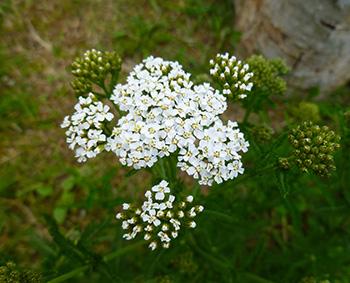 Yarrow is one of the easiest plants to grow and requires little care or attention. Yarrow is considered a no-fuss, foolproof herb that fits nicely into any garden.
Yarrow is one of the easiest plants to grow and requires little care or attention. Yarrow is considered a no-fuss, foolproof herb that fits nicely into any garden.
Allow Yarrow to grow to maturity when the flowers are fully open and cut it off at the bottom of the stem with the head still attached to harvest.
Hang the harvested plant upside down to dry for several days before use.
Every part of the Yarrow plant has a medicinal purpose. You can also store Yarrow in an airtight container for up to a year. If you wish to use the root of the Yarrow plant, you should ensure that it is at least two to three years old and must be dried for a week before use. However, you can harvest small pieces of the root over time, leaving the remaining plant intact to grow again.
⇒ Get Your Own Yarrow Seeds, Last 30 Packs Left!
How To Identify Yarrow:
Yarrow is not difficult to identify, and its distinctive scent is a good indicator that can help you avoid mistakes. Yarrow has a strong, sweet smell that is similar to chrysanthemums. Yarrow also has a bitter taste that is equally as strong as its scent. These plants can reach more than 3 feet high at maturity but generally stay between 1 and 3 feet.
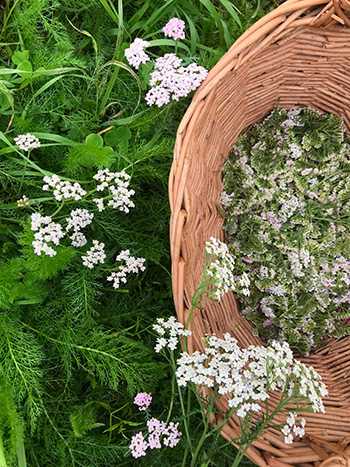
- Yarrow Leaves: The leaves of the Yarrow plant resemble a feather and are evenly distributed on the stem. The leaves at the base are larger than those at the tip but are relatively small in size
- The Stem of the Yarrow Plant: A Yarrow stem is ridged and angular. Fibrous in texture, the stem of this plant easily holds the hairy leaves and small fruits and flowers that adorn it.
- The Flowers: Yarrow blooms are composite and can be seen from the start of summer into the early fall. Individual Yarrow blooms consist of between 15 and 40 small, round, white or pale pink flowers with bright yellow centers.
- Yarrow Fruits: The Yarrow plant is adorned with small fruits that contain a seed. Growing to around 2mm, the fruits of the Yarrow are long, narrow, and oblong.
⇒ Plant Identification Guide – 400 Wild Plants That You Can Forage For (Video)
Copy Cats:
Like many plants, there are look-a-likes, and you must be aware of the differences.
One such plant that resembles Yarrow is Poison Hemlock. Poison Hemlock is highly toxic and is not edible. Consuming any part of this plant is extremely dangerous. However, aside from fragrance, one main difference between Poison Hemlock and Yarrow is the leaf shape. The leaves of Poison Hemlock are more triangular than Yarrow leaves.
Hemlock also tends to have a thick stalk with purple spots.
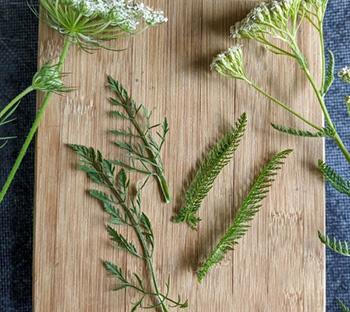
Queen Anne’s Lace is similar to Yarrow but is typically a bit larger, though not always. The main differences between the two plants are the stems and flowers. Queen Anne’s Lace has a hairy stem and flowers lacking a distinct yellow center. Instead, Queen Anne’s Lace can be found with red or purple blooms in the center of each head. Unlike the Yarrow plant, Queen Anne’s Lace tends to smell more like a carrot that has been crushed.
Lastly, Sweet Fennel is sometimes mistaken for Yarrow. While edible and relatively safe, this plant will not help your health issues. Spotting the differences between these two plants can be more challenging if you are not aware of what to look for, but the stem of Sweet Fennel will be slightly grooved, and the flowers will be flat-topped with yellow heads. Sweet Fennel has a licorice smell that differs from the distinct smell of Yarrow as well.
⇒ How to Tell the Difference Between Yarrow and the Poisonous Hemlock
The Many Medicinal Uses of Yarrow
Yarrow can be used in many ways, from teas to tinctures; it is an excellent tool for treating many common ailments.
Some Medicinal Uses of Yarrow Include: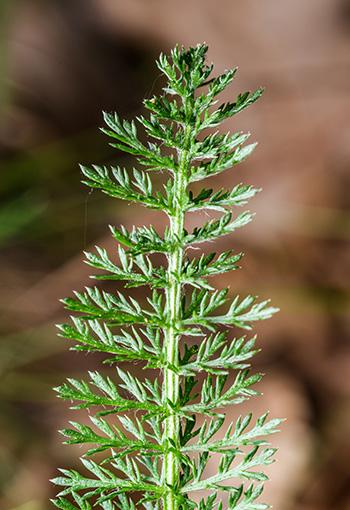
- It is used to treat wounds
- It helps to stop bleeding
- It can be used as a digestive herb
- It has diuretic potential
- It is an anti-inflammatory
- It is anti-spasmodic
- It helps to remove excess mucous from the body
- It reduces fever
- It lowers blood pressure
- It stimulates blood flow in the pelvic area (especially the uterus)
- It is antimicrobial
- It can be used to treat pneumonia
- It can help ease rheumatic pain
Often referred to as the “ultimate prepper herb,” Yarrow has been a crucial medical tool for centuries and has even been used to treat soldiers’ wounds in battle.
Using Yarrow as a Health Aid:
The Yarrow plant is packed full of beneficial active ingredients. Compounds including Asparagine, Achilleine, Archilletin, Bitters, Calcium Salts, Potassium, Flavonoids, Isovaleric Acid, Salicylic Acid, and Sterols exist within the Yarrow plant and provide numerous health benefits.
Yarrow has astringent, antiseptic, antibacterial, anti-inflammatory, anti-spasmodic, coagulant, blood thinning, diaphoretic, and hypotensive abilities. The list of things this plant can do is impressive, and the true power of this natural miracle remains unknown. However, there are many established uses for Yarrow, which we explore in the table below:
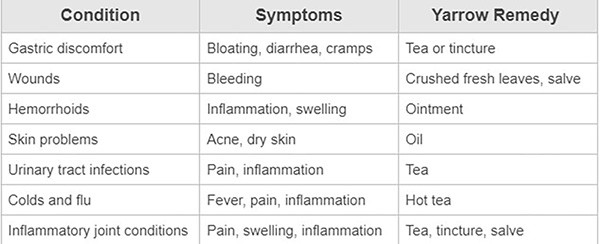
Yarrow Remedies:
The preparation of Yarrow depends on the ailment you are looking to treat and its specific symptoms. Although there is a plethora of anecdotal evidence available, like many natural remedies, there is a significant lack of clinical studies on the effectiveness of Yarrow in disease treatment.
How To Make Yarrow Teas and Tinctures:
Yarrow tea is the most common form of consumption. All plant parts are consumable, from the leaves and stem to the flowers and roots. However, most remedies rely on the leaves and flowers to create medicines.
Note: Most remedies that utilize Yarrow require it to be in powdered form. Using a mortar and pestle or a blender can create Yarrow powder, or it can be purchased online.
Yarrow Tea
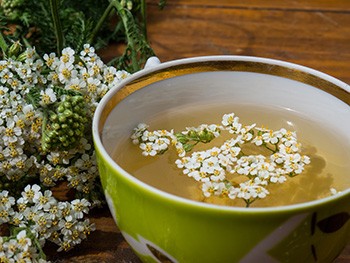
Yarrow Tea is straightforward to make. Creating Yarrow tea is as simple as mixing one heaping tablespoon of the herb into a cup of boiling water. However, since the taste is quite bitter, you may want to add honey or another herb to the mixture to make it more palatable.
On the other hand, creating a Yarrow tincture requires more effort and some added patience. While the process itself is quick, the time it takes for the mixture to form is not as speedy.
Simple Yarrow Tincture:
Ingredients
- 3 ½ tablespoons of dried Yarrow chopped into a fine powder.
- 10 tablespoons of alcohol > 80% proof, such as vodka.
Steps
- Place the Yarrow in a glass jar that has a lid.
 Pour alcohol over the herb.
Pour alcohol over the herb.- Stir gently, ensuring the herb is saturated.
- Cover the stirred mixture with an airtight lid, and adorn a label to the jar.
- Store the jar in a cool, dark place for 6-8 weeks.
- After 8 weeks, strain the liquid from the mixture into an appropriate glass container or eyedropper jar and affix a label to the bottle.
The use of the alcohol allows this tincture to be safely stored for 1 to 1 ½ years. Any change in aroma will indicate that it is time to throw it away.
You can find a ready-to-use yarrow tincture in the apothecary.
Dosage:
The preparation of Yarrow depends on numerous factors. Age, general health, underlying conditions, current medications, the type of condition you are looking to treat, and how you plan to use the product all play a role in dosage.
The following guidelines may help with dosing Yarrow for medicinal use. 1-3 cups of Yarrow Tea will be safe for most people to consume daily. The tincture described above can be added to water 1-3 times a day with little risk. Dosage for Yarrow Tincture consists of 20-40 drops daily.
Note: As with any treatment, it is suggested that you speak with your healthcare provider before you begin using Yarrow to treat any ailment to avoid conflicts or complications.
Storing and Preserving Yarrow:
Yarrow is best preserved by drying the plant, which helps to retain its medicinal properties and extend shelf life.
To preserve Yarrow: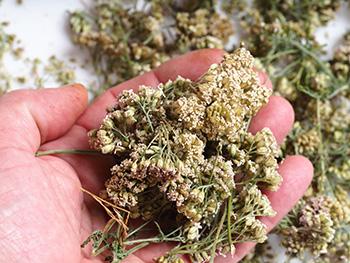
- spread the leaves and flowers in a thin layer on a drying screen.
- Place the screen with the Yarow in a well-ventilated area that is well-shaded.
- Turn, flip, and move the flowers regularly to encourage even drying and prevent mold growth.
- Once the leaves and flowers are sufficiently dry and crisp to touch, place them in a clearly labeled airtight container, and store them in a dry, dark place.
Note: Do not wash or rinse the flowers before drying, as this can impact the medicinal properties and cause mild growth. If the Yarrow shows signs of mold or mildew, it must be thrown away immediately.
Warnings:
Just because something is natural does not mean it is safe. As with all remedies, there are warnings and cautions that you must be aware of before using Yarrow to treat any condition. Always talk with a healthcare provider before beginning any new type of treatment, natural or otherwise.
The following people should avoid Yarrow:
- Pregnant or breastfeeding women
- Those who are trying to get pregnant – This applies to both women and men
- Anyone with a bleeding disorder. – Yarrow works as a blood thinner and can cause severe complications if used by someone who has a bleeding disorder.
- Individuals who are allergic to plants in the daisy family, including daisies, marigolds, ragweed, chrysanthemums, etc.
- People who are scheduled for surgery anytime in the next two weeks
- Those taking certain medications, such as:
- Blood thinners
- Lithium
- Sedatives or barbiturates
- Some antacids (check with your doctor or pharmacist)
- Drugs that reduce gastric acid / H2-blockers
Common Combinations:
Yarrow is safe for use with children and may also be combined with other herbs.
- Blessed Thistle can be combined with Yarrow to aid digestion, and sage will help strengthen the liver and support the function of the stomach. Combining the two as a digestive bitter will increase bile flow, and since both herbs relax nervous tension, this combo can be used as a soothing menstrual tonic.
- Yarrow can also be combined with Lavender to relieve excess gas and ease bloating. The addition of Motherwort is used to treat premenstrual tension, nervousness, mood swings, and cramping as well. In contrast, Corn Silk is paired to treat urinary tract infections.
- Mixing Peppermint with Yarrow creates a diaphoretic for treating colds and flu. Peppermint also neutralizes Yarrow and gives it a more pleasant taste. Another way to utilize Yarrow in cold and flu is by adding Elderberries. This combination is excellent for treating colds and flu and can also be used as a blood tonic to treat anemia or poor circulation.
- Alternatively, Olive leaves can be mixed with Yarrow to create a general tonic that improves circulation and immunity.
What You Should Know About Foraging Yarrow
Why You Should Chew Yarrow (Video)
Natural Home Wound Care: Dos and Don’t’s
The Best Flowers to Attract Beneficial Insects to Your Garden








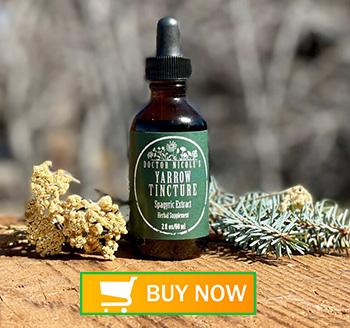


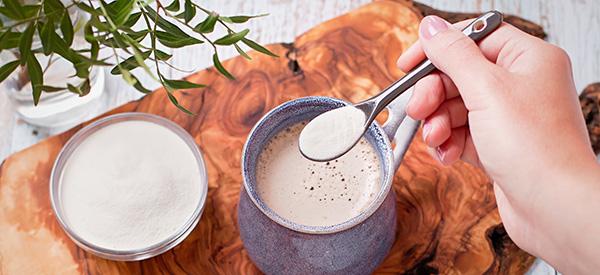
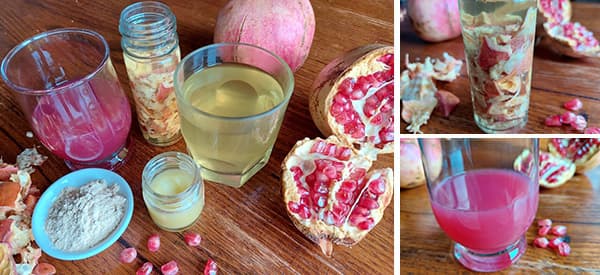
I tried to order the medicinal garden kit but you only ship to US
That sucks! I was going to order too, but I’m in Canada . I heard theres a company in B.C , if your from canada as well…
Hands down, my favorite plant! I’m fortunate to live atop a meadow teeming with wild Yarrow. I had a nasty fall last year and there she was, right in front of me, ready to stop the bleeding and heal the deep wounds. My hand looked like it had green stitches and now you can’t even see the scars. 🙂
I have a type of yarrow that has gray green leaves and not fine, but definitely fern-like. Is this also good for all the uses of the others?
Yarrow has gray green foliage when it is very dry. The more moisture it gets, the greener it will be. Check the flowers. Yarrow flowers are very distinctive and you should be able to match them to a photo in this post or on the web. 🙂
I have yellow yarrow in my garden. Can it be used interchangeably with white?
The yarrows bred for beauty are considered inferior when making plant medicine. White is more potent, especially when grown in poor soils. The more it is neglected, the more the oil content increases.
I’m so blessed to have found this site. The information is so valuable. I live in the mountains of Kentucky and am so blessed ! You are a goddess sed . thank you all !!
Do you know why yarrow can’t be used if someone uses Drugs that reduce gastric acid / H2-blockers….is it because of possible bleeding?
I am so blessed to have a friend who has given me access to The Lost Herbs. After 63 years of Nursing in the Allopathic System I am excited to be involved now in the “Garden” System.I realise however,that advice must be very cautious.
I am trying to soak up all the information I am able by reading and watching videos. My husband and I bought a lot of the materials your group offers. Thank you, and everyone in your group for all the great teaching!